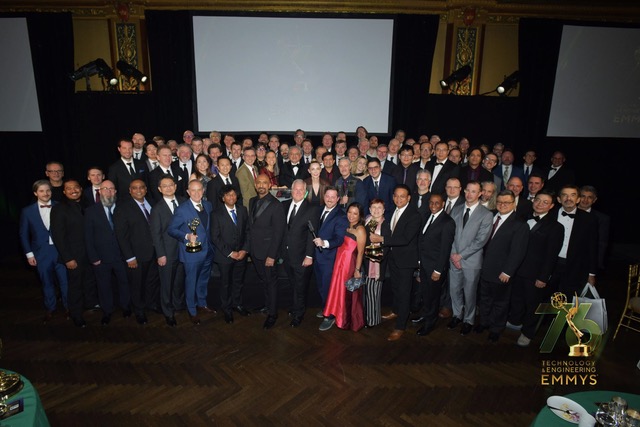Grass Valley's Alain Andreoli addresses IABM
The International Association of Broadcast Manufacturers (IABM) held its annual conference Nov. 29-30 in Windsor, UK. The trade association represents broadcast and media technology suppliers, providing members with market research, event services and training.
With the rather direct tagline, "Adapt or Die?", the conference focused on the great changes the industry is undergoing, along with the financial impact. The conference brought together senior managers from a cross-section of the technology suppliers to hear presentations and to network over the two days.
Alain Andreoli
Grass Valley president and CEO Alain Andreoli presented the keynote, titled: “Growth and recovery, what it means for our industry”. With Grass Valley in a period of turnaround since the acquisition by Francisco Partners, Alain is well placed to comment on the challenges faced by manufacturers.
Andreoli has a background in IT, software and consumer electronics, so he can see the broadcast sector in the broader context, a useful asset as IT now permeates broadcast operations.
Andreoli’s keynote covered much ground, starting with a round up of the development of IT, citing parallels with broadcast technology, and a few pointers to where he believes broadcast technologist are going wrong. He described how storage has evolved from islands of direct-attached storage, through SANs and NAS to reach data lifecycle management and now a unified storage utility, private or outsourced (“The Cloud”)
He developed his argument by describing three phases of IT.
The professional video industry's #1 source for news, trends and product and tech information. Sign up below.
Phase 1: Companies operated a private computer system in house. Applications included SAP and Oracle. The applications ran on middleware from Microsoft, Unix, Java etc. and used hardware from companies including EMC, Dell and Cisco. Vendors like IBM and HP represented one-stop shops for software and hardware.
Phase 2: More recently, the network has become the computer, with on-demand utilities like Amazon and Rackspace. Users communicate though third parties like Blackberry and Google and social media from the likes of Facebook have become part of the corporate communications stack.
Andreoli defines Phase 3 as an always-on wireless era, just around the corner.
In this rapid tour of IT, he noted how a small number of vendors provide the products and services.
Moving on to broadcast, he made the observation that it is two-headed business; it was invented by technologists but taken up by creatives. Contrast the financial and manufacturing sectors, which existed before the IT that serves them. This two-headed origin of broadcasting still persists with broadcast technologists remaining powerful.
Through their power, broadcast technologists supported an infinity of proprietary standards, and an infinity of “small” specialist vendors. Andreoli noted that broadcast technologists like to purchase best of breed products from small specialist vendors.
Andreoli fell back into analogy, with hunter-gathers and farmers, describing the broadcast industry as a zoo, “it must change into a farm.” He defines the farm as a seamless contents management factory, ultimately a utility. To build the farm, he advocates a smaller group of vendors with interoperating solutions, much like the IT industry has been for a decade or more “Our space need a few specialized but scaled “IBM-Like” leaders who can unify the contents lifecycle management and reduce costs.”
Andreoli quoted Dave Pendleton, COO, ABC Australia: “We must now design our business and technology platform for the Internet era. Over the next 3-5 years, the broadcaster will become a super multiplatform media-hub, creating live media contents and protecting its media assets in its central repository (private cloud). Its long term survival and success will depend on its capability to monetize this cloud in a variety of ways (linear or push-pull) on a multitude of platforms (TV, tablets, phones...) primarily through the Internet.”
File-based operations
The enabler for the new world is file-based operations and IT’s phases 2 and 3 are fostering the new media revolution. “The fragmentation of broadcast technologies has become unmanageable. To meet the demands of the new media landscape vendors need to move to sell solutions and services.” said Andreoli.
File-based operations allow broadcasters to switch to IT technology, and the migration is happening fast. The closed best-of-breed systems must give way to open architectures. Andreoli proposes that broadcasters drive for fewer vendors with a broader breadth of products and services.
Planners should drive out processes and outsource; turn fixed costs into variable – through OPEX rather than CAPEX – to enable more fluid business models. Part of this move away from best-of-breed to simpler system that are fit for purpose is the concept of “good enough”.
“Good enough”
Broadcasters technologists talk about “Broadcast Quality” as some sort of gold standard. Striving for the best pushes up costs. Directors are finding that consumer cameras costing a few hundred dollars can be pressed into service, intercut with products costing tens of times more. This is the rise of “good enough." Not all content warrants the best technology,
Another speaker Peter Angel, COO of media company IEC in Sports, expressed the view that “our business needs to embrace ‘good enough’. Take YouTube as an example.”
Angel cited the World Cup production budget of $200M. Next week his company may be covering a tennis match, which could be a $5000 dollar event, “but we use the same equipment. Sport is using more equipment and more people, but content is not always high value like World Cup. The content is the issue, not what it has been shot on.” And referring to today’s young people “The generation in five years time, will not be interested in broadcast.”
A thought-provoking address with more than a few hints at the direction Grass Valley is taking. But a little unpalatable for those IABM members who make up the infinity of “small” specialist vendors. Ultimately, the multimedia content producers will decide what platforms suit their business needs.
